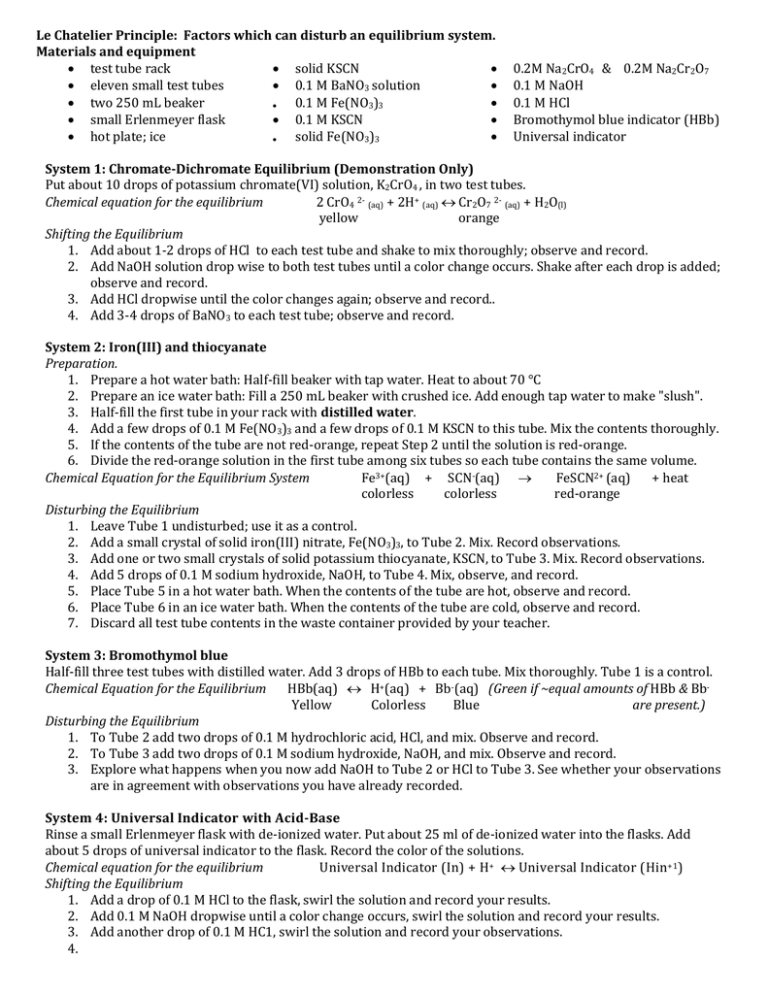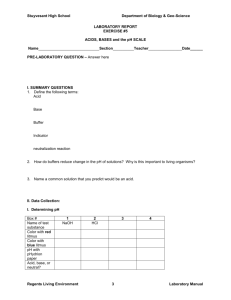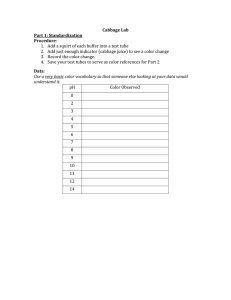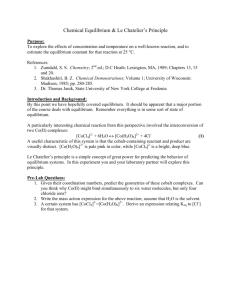Equilibrium honors student - Sayers-ONeill
advertisement

Le Chatelier Principle: Factors which can disturb an equilibrium system. Materials and equipment test tube rack solid KSCN eleven small test tubes 0.1 M BaNO3 solution two 250 mL beaker 0.1 M Fe(NO3)3 small Erlenmeyer flask 0.1 M KSCN hot plate; ice solid Fe(NO3)3 0.2M Na2CrO4 & 0.2M Na2Cr2O7 0.1 M NaOH 0.1 M HCl Bromothymol blue indicator (HBb) Universal indicator System 1: Chromate-Dichromate Equilibrium (Demonstration Only) Put about 10 drops of potassium chromate(VI) solution, K2CrO4 , in two test tubes. Chemical equation for the equilibrium 2 CrO4 2- (aq) + 2H+ (aq) Cr2O7 2- (aq) + H2O(l) yellow orange Shifting the Equilibrium 1. Add about 1-2 drops of HCl to each test tube and shake to mix thoroughly; observe and record. 2. Add NaOH solution drop wise to both test tubes until a color change occurs. Shake after each drop is added; observe and record. 3. Add HCl dropwise until the color changes again; observe and record.. 4. Add 3-4 drops of BaNO3 to each test tube; observe and record. System 2: Iron(III) and thiocyanate Preparation. 1. Prepare a hot water bath: Half-fill beaker with tap water. Heat to about 70 °C 2. Prepare an ice water bath: Fill a 250 mL beaker with crushed ice. Add enough tap water to make "slush". 3. Half-fill the first tube in your rack with distilled water. 4. Add a few drops of 0.1 M Fe(NO3)3 and a few drops of 0.1 M KSCN to this tube. Mix the contents thoroughly. 5. If the contents of the tube are not red-orange, repeat Step 2 until the solution is red-orange. 6. Divide the red-orange solution in the first tube among six tubes so each tube contains the same volume. Chemical Equation for the Equilibrium System Fe3+(aq) + SCN-(aq) FeSCN2+ (aq) + heat colorless colorless red-orange Disturbing the Equilibrium 1. Leave Tube 1 undisturbed; use it as a control. 2. Add a small crystal of solid iron(III) nitrate, Fe(NO3)3, to Tube 2. Mix. Record observations. 3. Add one or two small crystals of solid potassium thiocyanate, KSCN, to Tube 3. Mix. Record observations. 4. Add 5 drops of 0.1 M sodium hydroxide, NaOH, to Tube 4. Mix, observe, and record. 5. Place Tube 5 in a hot water bath. When the contents of the tube are hot, observe and record. 6. Place Tube 6 in an ice water bath. When the contents of the tube are cold, observe and record. 7. Discard all test tube contents in the waste container provided by your teacher. System 3: Bromothymol blue Half-fill three test tubes with distilled water. Add 3 drops of HBb to each tube. Mix thoroughly. Tube 1 is a control. Chemical Equation for the Equilibrium HBb(aq) H+(aq) + Bb-(aq) (Green if ~equal amounts of HBb & BbYellow Colorless Blue are present.) Disturbing the Equilibrium 1. To Tube 2 add two drops of 0.1 M hydrochloric acid, HCl, and mix. Observe and record. 2. To Tube 3 add two drops of 0.1 M sodium hydroxide, NaOH, and mix. Observe and record. 3. Explore what happens when you now add NaOH to Tube 2 or HCl to Tube 3. See whether your observations are in agreement with observations you have already recorded. System 4: Universal Indicator with Acid-Base Rinse a small Erlenmeyer flask with de-ionized water. Put about 25 ml of de-ionized water into the flasks. Add about 5 drops of universal indicator to the flask. Record the color of the solutions. Chemical equation for the equilibrium Universal Indicator (In) + H+ Universal Indicator (Hin +1) Shifting the Equilibrium 1. Add a drop of 0.1 M HCl to the flask, swirl the solution and record your results. 2. Add 0.1 M NaOH dropwise until a color change occurs, swirl the solution and record your results. 3. Add another drop of 0.1 M HC1, swirl the solution and record your observations. 4. Honors Chem Lab Report: Factors which can disturb an equilibrium system. Chromate-Dichromate Equilibrium Data: System 1 Tube 1 Observation K2CrO4 solution only HCl added NaOH added HCl added BaNO3 added Direction of Shift Name_________________________ Tube 2 Observation Direction of Shift Iron(III) and thiocyanate Data: System 2 1 2 3 4 5 6 Disturbance none Solid Fe(NO3)3 Solid KSCN NaOH ↑temperature ↓temperature Observed Change Bromothymol blue Data Disturbance Observed Direction of System 3 Change Shift 1 none 2 HCl 3 NaOH Universal Indicator Data System 4 Observed Change Deionized water and Universal Indicator HCl added NaOH added HCl added again Direction of Shift Disturbance Observed Change Direction of Shift none NaOH HCl Direction of Shift Questions and Analysis 1. What observation in System 1 demonstrates that this is a reversible reaction. 2. Which ion forms an insoluble product when combined with Ba2+? 3. Effects of Temperature Change a) When heat is added, how does the direction of shift relate to the side on which the heat term is written? b) When heat is removed, how does the direction of shift relate to the side on which the heat term is written? c) Write a rule which would allow you to predict how other systems would shift if disturbed in this way. 4. Effect of Concentration Change a) When Fe(NO3)3 is added to System 2, what is the role of the NO3- ion? b) When Fe(NO3)3 is added to System 2 did it shift the equilibrium to the side in which Fe 3+ is written or the other side? c) When KSCN is added to System 2 did it shift the equilibrium to the side in which SCN- is written or the other? d) Write a rule which would explain how the direction of shift relates to the side of the chemical reaction on which the substance with increased concentration is written. 5. What effect did adding 0.1 M NaOH (containing aqueous Na+ and OH- ions) have on System 2? Since neither Fe3+(aq) or SCN-(aq) were added, how do you explain your results? 6. What specific physical change does the addition of H+ ions have on each indicator, bromothymol blue and universal indicator. (May have to Google this) 7. Write a statement summarizing how an equilibrium reacts to disturbance.







